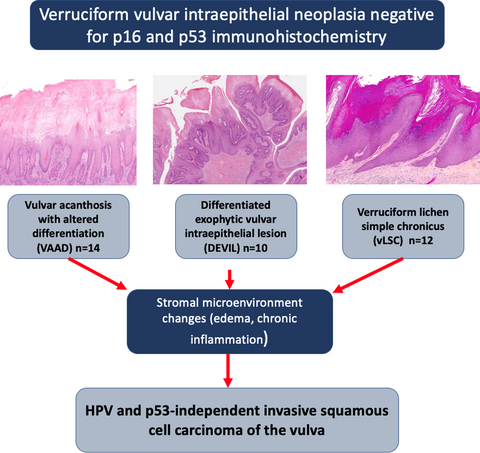DEVIL, VAAD and vLSC constitute a spectrum of HPV-independent, p53-independent intra-epithelial neoplasia of the vulva
Abstract
Aims
We aimed to characterise a large cohort of non-invasive, human papillomavirus (HPV) and p53-independent verruciform lesions, such as ‘vulvar acanthosis with altered differentiation’ (VAAD), ‘differentiated exophytic vulvar intra-epithelial lesion’ (DEVIL) and ‘verruciform lichen simplex chronicus’ (vLSC).
Methods and results
From January 2008 to December 2020 we retrospectively identified 36 eligible patients with verruciform non-invasive lesions (n = 36) and collected clinical, histological and follow-up parameters. Verruciform non-invasive lesions occurred at a median age of 71 years, with a median follow-up of 33.5 months. Clinically, pruritus was only reported in patients with VAAD (n = 3, 21%). Lesion colour was significantly different across categories (P = 0.028). Apart from the histopathological criteria already known to distinguish these entities (hypogranulosis, epithelial pallor and low-magnification architecture), no other significant criteria were discovered and significant overlap was observed, particularly between VAAD and DEVIL. Patients with vLSC trended towards longer survival without recurrence compared to VAAD and DEVIL (P = 0.082), but showed comparable invasion-free survival interval (P = 0.782). Squamous cell carcinomas (SCC) associated with either VAAD, DEVIL or vLSC displayed similar clinical, histopathological and biological parameters. In non-invasive precursor lesions, stromal oedema was associated with invasion (P = 0.015) and remained so upon Cox regression analysis (P = 0.009).
Conclusion
Our study of HPV and p53 independent non-invasive verruciform lesions of the vulva highlights significant clinical, histopathological and biological overlap between VAAD, DEVIL and vLSC, suggesting that these pre-invasive lesions should be viewed as a spectrum. We also show that stromal features such as oedema might play an import role in progression to invasion.
Graphical Abstract
Conflicts of interest
The authors declare no potential conflicts of interest with respect to the research, authorship and/or publication of this article.





